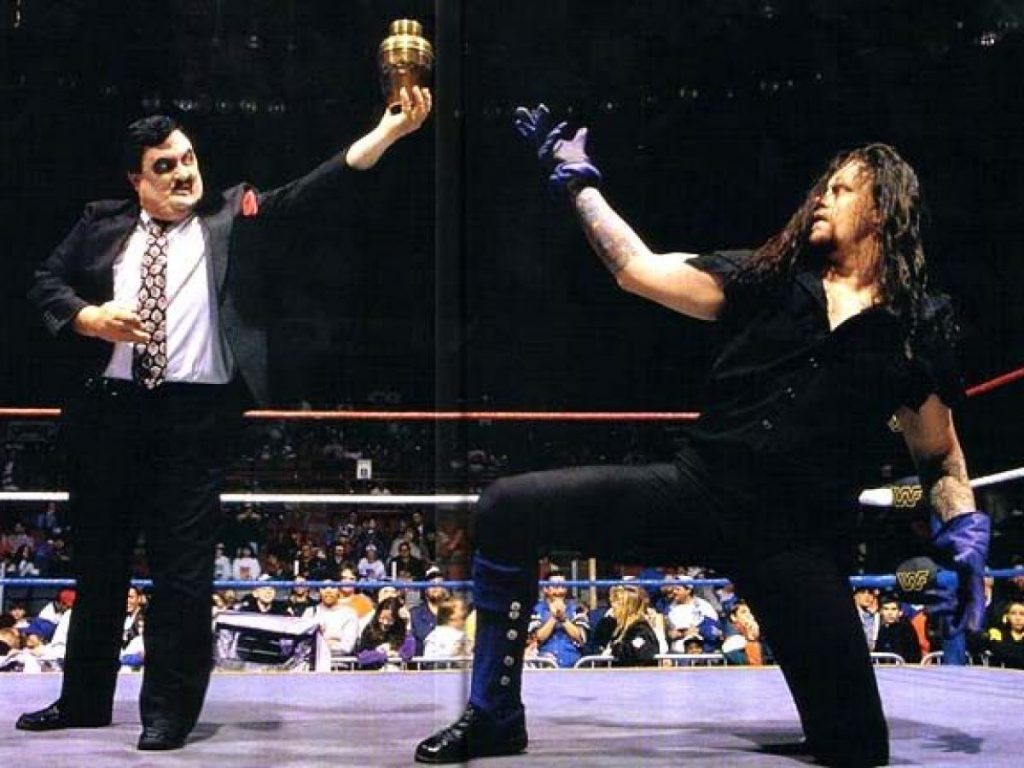
Christopher Hurt is an REL alum who works in tech in Los Angeles. He is best known for his work with the rock ‘n’ roll group, Jamestown Pagans.
Without a doubt my favorite professional wrestler has always been, and will always be, The Undertaker. The Undertaker is a character performed by Mark William Calaway in World Wrestling Entertainment (back in my day it was WWF). Recently the WWE released a documentary chronicling the 30 year career (and retirement) of Calaway. It got me thinking about studying religion.
There are quite a few videos out there that go through the major story arcs, rivalries, and matches that make The Undertaker’s career unrivaled. For example, see this video for context to this article:
Calaway was heavily involved in the development of his character. WWE had to continually evolve its storytelling, performance-style, and characters as its audience changed over the years. The Undertaker, for example, has been an old western mortician, the leader of a seemingly-satanic cult, and an American badass throughout his career, just to name a few.
There are a number of variables at work that maintain Calaway’s Undertakerness. That is, while entrance music, pyrotechnics, and costumes change, what other things remain in the rotation to give the impression of a consistent identity? I’m thinking here of movements (how The Undertaker throws a punch) and wrestling moves (jumping clothesline, chokeslam, rope walk, and the aptly named finishing move, the Tombstone Piledriver). With so many things changing throughout Calaway’s career, it seems difficult to think of a scholar of professional wrestling trying to nail down Undertakerness.
Yet, if we substitute religion in the place of Undertakerness we can see a long list of scholars who have done, and continue to do, just that. And while I’m in no position to be prescriptive and tell academic folks what they ought to do, I do find as much merit in studying how identities are constructed, maintained, and performed as I do in studying attempts to essentialize incredibly complex and seemingly timeless social practices.
What would be interesting would be an attempt to “redescribe” (i.e., ‘theorize’) some of the dynamics in pro wrestling which, as of now, only has folk language, much of it from pro wrestling’s roots in carny culture or more recently from MMA, to label it. How might we redescribe what it means for a wrestler to “get over,” or “to pop” or “to shoot”? What might a theory of “kayfabe” look like?
So, I have a book project on the back burner to do something like that. Also the reverse, how might kayfabe help us theorize belief and disbelief? How might getting over help us understand charisma? There’s a lot there!
Thank you Mike! That is a really interesting way to think about this that never crossed my mind. The ebb and flow of those participants is undoubtedly affecting this idea. It makes me think about the impression of “Undertakerness” from the perspective of someone in attendance vs. television audience. On the one hand, you’ve got someone who is there. On the other, you have someone is seeing from multiple angles with commentary (it doesn’t get any better than Vince McMahon commentating on an Undertaker entrance from the early 90’s).
This is excellent. You could take the Durkheimian turn and say that “Undertakerness” isn’t actually in/on Mark Calloway but is really the product of the audience. That is, the reason there is an Undertaker across all the various Undertakers is because the audience has continued to accept a single identity across Calloway’s various iterations. The opposite of the Undertaker is someone like Ed Leslie (https://en.wikipedia.org/wiki/Brutus_Beefcake) who had a ton of characters and no underlying identity that held them together because the audience never imagined him that way. So, the production of Undertakerness is this back and forth between the performer, the writer/producers at WWE, and the audience.